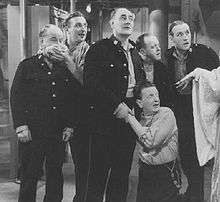The Crazy Gang

The Crazy Gang were a group of British entertainers, formed in the early 1930s. In the mature form the group's six men were Bud Flanagan, Chesney Allen, Jimmy Nervo, Teddy Knox, Charlie Naughton and Jimmy Gold. The group achieved considerable domestic popularity and were a favourite of the royal family, especially King George VI.
Formation of the Crazy Gang
Although George Black is often credited with the formation of the Crazy Gang, the start was more complicated. In 1931 three double acts (Nervo and Knox, Naughton and Gold and Billy Caryll and Hilda Mundy) were tentatively booked at the London Palladium. This caused Black to consider cancelling one of the couples. Nervo and Knox had a technique of entering other acts and Black was persuaded to overcome the difficulty by letting this happen. The show, which was called "Crazy Week" opened on 30 November 1931. Other Crazy Weeks followed with Flanagan and Allen added. The name Crazy Gang was not used until 1937.
The popularity of the Gang is seen through a reference to "Crazy Week" in Alfred Hitchcock's movie The 39 Steps (1935 film), which has its conclusion at the Palladium.
Composition
The members were: Bud Flanagan, Chesney Allen, Jimmy Nervo, Teddy Knox, Charlie Naughton and Jimmy Gold and sometimes 'Monsewer' Eddie Gray. Essentially the gang comprised three double acts; Flanagan and Allen, Naughton and Gold, and Nervo and Knox (with some input from Gray). They had all had entertainment success before the Crazy Gang but not of the same magnitude. It was natural for them to get together as they shared a similar style of comedy and worked on the same bills at theatres.
Career
The gang appeared first in their own stage show Crazy Week at the London Palladium, which later became their adopted home, but then made several films. The first was O-Kay For Sound, in 1937, and the best remembered was their war-time film Gasbags (1940). They kept people entertained during the war years with their irreverent comedy style, and Flanagan and Allen's very popular songs also contributed to their success. All their films were directed by Marcel Varnel, the Frenchman who directed a long list of classic British comedies for Will Hay, George Formby and others. Moore Marriott, who was a frequent co-star of Will Hay, often turned up in their films. Eddie Gray, their associate and equally crazy comic, appeared in the later Life Is a Circus (1960 film) only.
Later they made Life Is A Circus (1958), starring Shirley Eaton, in which Flanagan and Allen again performed their biggest hit, "Underneath the Arches". Chesney Allen withdrew from live performances in later years due to ill health, though he outlived all the others. The Gang made a television series, The Gang Show, in 1956. The Gang was understudied by Peter Glaze.
Among the other acts who worked with The Crazy Gang was Teddy Brown, a very tall and enormously heavy American percussionist. His speciality was to perform on the xylophone. His other role was to be the butt of practical jokes by the Gang; at one performance Flanagan and Allen took to the stage each encased in one leg of Brown's trousers while Brown frantically called from the wings trying to get them back. His relationship to the main members was similar to that of Eddie Gray. Another star who worked with the gang was the actor Stanley Holloway, who often stood in for Bud Flanagan when he took time off for contractual reasons.
They were asked to do many Royal Command performances (their last was in 1961), and they also did private performances for the royal family. Although they were most popular in Britain and the Commonwealth, they still have their fans in America. Perhaps the best remembered of their gags is when an attractive girl in a grass skirt is followed across stage by Bud Flanagan wheeling a lawnmower.
Films
- O-Kay for Sound - 1937
- Alf's Button Afloat - 1938
- The Frozen Limits - 1939
- Gasbags - 1941
- Life Is a Circus (1960 film) - Filmed in 1958, released later.
Stage Shows
- Life begins at Oxford Circus - a revue at the London Palladium 1935
- Round About Regent Street - a revue at the London Palladium 1935
- All Alight at Oxford Circus - a revue at the London Palladium 1935
- Okay for Sound - at the London Palladium 1936
- London Rhapsody - at the London Palladium 1937
- These Foolish Things - at the London Palladium 1938
- The Little Dog Laughed - at the London Palladium 1939
- Together Again - at the Victoria Palace 1947
- Knights of Madness - at the Victoria Palace 1950
- Ring out the Bells - at the Victoria Palace 1952
- Jokers Wild - at the Victoria Palace 1954
- These Foolish Kings - at the Victoria Palace 1956[1]
- Clown Jewels - at the Victoria Palace 1959
- Young at Heart - at the Victoria Palace 1960
Note: Chesney Allen did not regularly perform with the Gang after 1945 (except for Royal Variety Performances)[2] and Eddie Gray rejoined the group in 1956.[3]
Notes
- ↑ Hope-Wallace, Philip. "These Foolish Kings: Crazy Gang's Hilarity", The Manchester Guardian, 20 December 1956, p. 5
- ↑ Goldie, David. "Allen, (William Ernest) Chesney (1894?–1982)", Oxford Dictionary of National Biography, Oxford University Press, 2004; online edition, January 2011, accessed 29 May 2012 (subscription required)
- ↑ Goldie, David. "Crazy Gang (act, 1931–1962)", Oxford Dictionary of National Biography', Oxford University Press, 2004; online edition, January 2011, accessed 29 May 2012 (subscription required)
References
- Roger Wilmut (1985), Kindly Leave the Stage, Methuen - ISBN 0-413-59290-1
- Tony Staveacre (1986), Slapstick!: Illustrated Story of Knockabout Comedy, Harper Collins - ISBN 0-207-15030-3
External links
- The Crazy Gang from the BBC Guide to Comedy
- TVCream's Crazy Gang Page
- The Crazy Gang - A tribute